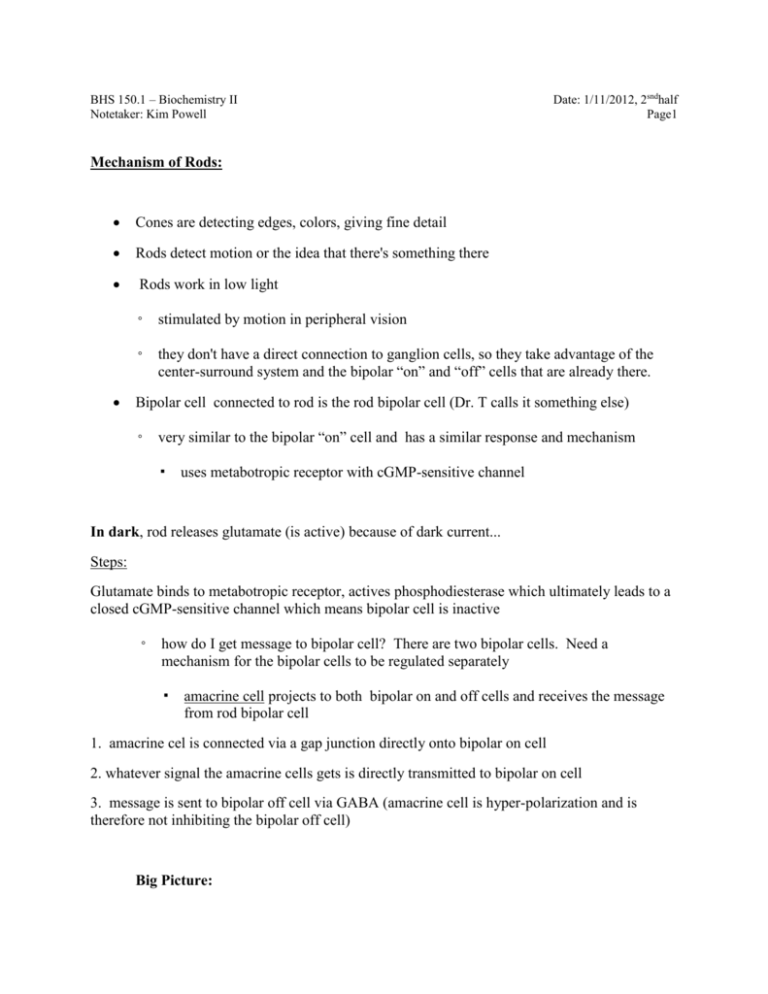BHS 150.1 – Biochemistry II Date: 1/11/2012, 2sndhalf Notetaker
advertisement

BHS 150.1 – Biochemistry II Notetaker: Kim Powell Date: 1/11/2012, 2sndhalf Page1 Mechanism of Rods: Cones are detecting edges, colors, giving fine detail Rods detect motion or the idea that there's something there Rods work in low light ◦ stimulated by motion in peripheral vision ◦ they don't have a direct connection to ganglion cells, so they take advantage of the center-surround system and the bipolar “on” and “off” cells that are already there. Bipolar cell connected to rod is the rod bipolar cell (Dr. T calls it something else) ◦ very similar to the bipolar “on” cell and has a similar response and mechanism ▪ uses metabotropic receptor with cGMP-sensitive channel In dark, rod releases glutamate (is active) because of dark current... Steps: Glutamate binds to metabotropic receptor, actives phosphodiesterase which ultimately leads to a closed cGMP-sensitive channel which means bipolar cell is inactive ◦ how do I get message to bipolar cell? There are two bipolar cells. Need a mechanism for the bipolar cells to be regulated separately ▪ amacrine cell projects to both bipolar on and off cells and receives the message from rod bipolar cell 1. amacrine cel is connected via a gap junction directly onto bipolar on cell 2. whatever signal the amacrine cells gets is directly transmitted to bipolar on cell 3. message is sent to bipolar off cell via GABA (amacrine cell is hyper-polarization and is therefore not inhibiting the bipolar off cell) Big Picture: 1. Glutamate binds to the metabotropic receptor on the rod bipololar cell 2. cGMP-sensitive channels close, which hyperpolarizes rod bipolar cell 3. hyper polarization of rod bipolar cell leads to hyper polarization 4. The hyper-polarization hyper polarizes the bipolar on cell 5. sends message that the light is off because bipolar on cell is hyper-polarized ◦ channel will be closed ◦ In low light, the center surround system is not very active because you're not getting bright light in the center-surround. ◦ rod is reinforcing that it's in the dark. In light, 1. Light hits rod and rod hyper polarizes because cGMP channels close 2. rod bipolar cell is active because glutamate was removed. 3. Since rod bipolar cell is active, amacrine cell is active 4. gap junction spreads activity it so that the bipolar on cell says the light is on and bipolar off cell is inhibited directly by GABA coming from amacrine cell 5. bipolar on says light is on 6. bipolar off says light is on “because i'm quiet” 7. this system is working in spite of what's happening in the center-surround because the rods are hijacking to send the message through. 8. Next page is for you to summarize- it's the whole system that you'll have to put together. 9. don't need to know the mechanism of how the the amacrine cells or horizontal cells are hyper-polarization or de-polarized Getting information to the brain: each eye detects parts of the left visual field and the right visual field crossing occurs at the optic chiasm so that the right side of your brian detects left visual world and the left side of your brains sees the right visual world information comes in to ganglion cells (with center-surround receptive field -CSRF) also we have have M cells and P cells ◦ P cells (small) are sensitive to color and form/shape ◦ M cells (big) are sensitive to motion ◦ ganglions terminate in the lateral geniculate nucleus (LGN) found in the thalamus ▪ LGN has six layers ▪ information is sorted by eye (R and L) ▪ layers are highly organized so that brain knows where information comes from ▪ two types of cells in the LGN: M and P cells ◦ M cells located in layers 1 and 2 ◦ P cells located in layers 3, 4, 5, 6 Go from LGN to the cortex, specifically the primary visual first (V1, area 17, striate cortex) and then to the extra striate cortex (V2, V4, V5, area 18, area 19, maybe area 20 and 21) ◦ in this region, motion information comes into area V1 and goes into layer 4 of striate cortex. It's just getting information across that something is moving (not telling the brain what it is) ◦ next it goes to extra striate cortex (V2) to an area called “thick stripes”. The motion information is direct. The identifying of the object will come with color and form. This is the simplest information coming through Color and form goes up to extra striate cortex as well, but it comes in where we have occular dominance columns (right and left eyes) and orientation columns which are bars of light oriented in different ways How do we go from center-surround receptive field to bars of light? ▪ See page 345 of notes two types of cells in the V1 area: simple cells and complex cells (cells in this area are known as interblobs) ◦ simple cells are summation of ganglion cells and LGN cells of the centersurround receptive field ▪ several LGN cells receive input from a different center-surround receptive field ▪ 3 or 4 project onto one simple cell and we get summation of receptive fields which produces a bar of light and the bar of light ▪ simple cells are set up by which orientation column they're in (by angle i.e. straight up and down) ▪ simple cells have one orientation ◦ complex cell receives input from several simple cells so instead of one bar of light there are multiple bars of light that are put together. They can come from the same or different orientations. The complex cells start adding it together to make form. ▪ For example, the complex cell might make a box out of bars of light in the same orientation. There might be one on the end, one in the middle, and on on the other end and the rest is filled in to make a box. ▪ Complex cells have multiple orientations Next multiple boxes get put together to make a complete image (which we won't talk about) Color Information: Color information goes into layer 3 of V1 (cells in this area are known as blobs) this information is sent to V2 V2 is still sorted but more complex than V1 because information is starting to be summated. The brain receives motions information, color and form information, and right and left visual field. All the information is put together to make forms with colors. -END OF MATERIAL FOR EXAM III-







